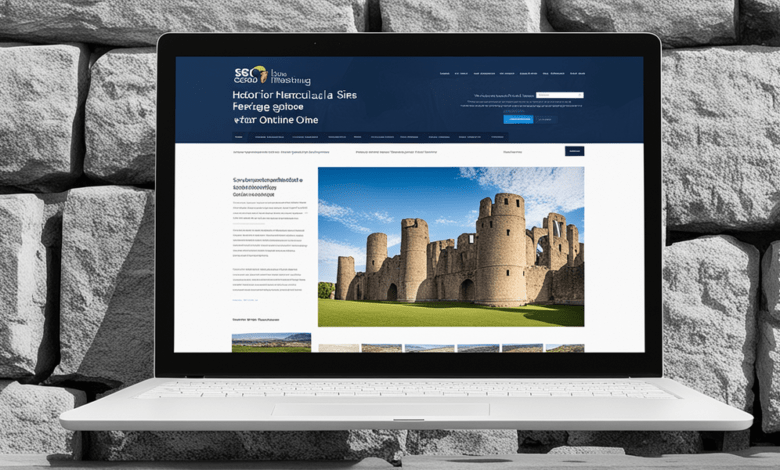
The best SEO for Historical and Cultural Sites Preserving Heritage Online 2023

Introduction
For historical and cultural sites, Search Engine Optimization (SEO) is a vital strategy to preserve heritage online and attract visitors to these valuable landmarks With the digital age providing unprecedented access to information, optimizing for SEO can significantly enhance the visibility of historical and cultural sites and foster a deeper appreciation for our shared heritage In this article, we will explore the significance of SEO for historical and cultural sites and effective strategies to preserve heritage online
1 Identify Your Target Audience and Site Significance
Identify your target audience, such as history enthusiasts, tourists, or individuals interested in specific cultural landmarks Conduct keyword research to understand popular historical and cultural site-related topics and search queries

2 Optimize Content s and Descriptions Cultural
Optimize your content s and descriptions by incorporating relevant historical and cultural site keywords naturally Clear and informative s can improve the discoverability of these sites
Conduct keyword research:
Start with thorough keyword research to identify terms and phrases related to your product or content. Use tools like Google Keyword Planner to understand the search terms your audience is using.
- Add naturally targeted keywords:
Include targeted keywords naturally in your content and product descriptions. Consider placing keywords in titles, headings, and content while maintaining readability. Aim for a balance between optimization and natural language. - Write an interesting title:
Clear, catchy headline that accurately describes the content or product. Headlines play an important role in attracting attention and encouraging users to learn more. - Create unique and informative content:
Develop unique and informative content that adds value to your audience. Whether it’s a product description or a blog post, focus on providing useful information, answering questions, and solving problems. - Optimize your title and meta description:
Optimize the meta title and description for your page. This element appears in search engine results and click-through rates. Make sure it is short, compelling and contains relevant keywords. - Use descriptive language:
Use descriptive language to clearly show the features and benefits of your product. Help users visualize the experience or benefits they will receive from your offering.
3 Create Engaging and Informative Content
Create engaging and informative content, including historical background, cultural significance, and architectural details Valuable content can foster a deeper understanding and appreciation for these landmarks
Know your audience:
Understand the interests, needs, and pain points of your target audience. Make your content meet their needs and provide solutions. Knowing your audience ensures that your content resonates with the right people.
Set clear goals:
Define a specific purpose for your content. Whether it’s to educate, entertain, drive traffic, or generate leads, setting specific goals guides your content creation strategy.
Catchy headlines:
Create catchy headlines that encourage users to click. A well-crafted headline is very important to attract readers to your content.
Tell a story:
Add story content to your content. People are naturally drawn to stories, and stories make your content more engaging and memorable. Share experiences, examples, or real-life examples to connect emotionally with your audience.
Give the first value:
Preload your content with valuable information. Engage your audience first by addressing their key concerns or providing immediate insight. Determine the value of your content first to engage the audience.
Use visuals effectively:
Integrate visually appealing elements into your content. This includes images, infographics, charts and videos. Visuals break up the text, improve understanding, and make your content more engaging.
Make sure they read:
Format your content for easy reading. Use short paragraphs, bullet points, and headings to break up the text. Clean formatting improves the user experience and encourages visitors to stay on your site.
Optimizing for SEO:
Add relevant keywords naturally to your content to increase search engine visibility. However, focus on creating content for people, not search engines. Optimize meta titles, descriptions and titles for better SEO performance.
4 Utilize Long-Tail Keywords
Incorporate long-tail keywords into your content to target specific historical and cultural site-related queries and cater to niche interests
Dive deep with long tail keywords: Attract targeted traffic and increase conversions
Imagine casting a net into the vast ocean. You can catch anything, but mostly seaweed and minnows. Now take a shot using a precision spear to target a special school of fish. The power of long tail keywords.
Gone are the days of relying on broad, general terms like “travel” or “holiday”. Today’s savvy Internet users search with intent, using specific phrases that define their needs and wants. Think “Best Family Friendly Hiking Trails Near Ososemite” or “Gluten Free Vegetarian Restaurants in Prague.” These longer and more focused keywords are called long tail keywords, and they are the key to unlocking a treasure trove of benefits for your website or online presence.
Here’s why you should focus on long-tail keywords:
Laser Target Traffic: Forget about unwanted visitors landing on your site after a quick browse. Long-tail keywords attract users who are already very interested in what you have to offer. They have done their research and know what they are looking for, which would be paying customers or engaged followers.
Less competition: Unlike their short-tail counterparts, long-tail keywords have less competition, which means they are easier to rank in search engine results pages (SERPs). This translates into more organic website traffic and increased visibility without having to break the bank on SEO.
Higher conversion rates: Visitors to your site using long-tail keywords are already prepared to take action. If they have identified a possible solution to a specific problem or need, they will be more interested in your suggestions. This translates into higher conversion rates such as purchases, subscriptions or downloads.
Improved user experience: By including long-tail keywords in your content and website structure, you speak directly to your target audience. This creates a more relevant and satisfying user experience, encouraging visitors to learn more and engage with your brand.
Content inspiration: Long tail keywords are a goldmine for content creation. They reveal your audience’s specific questions, concerns, and interests, providing valuable insight into what content will resonate with them. Use this knowledge to create blog posts, articles, videos, and social media content that truly meets their needs.
Ready to dive into the long tail keyword pool? Some tips to get you started:
5 Implement Structured Data for Site Information
Implement structured data markup for historical and cultural site information to enhance search results with rich snippets, such as historical facts and site images Rich snippets can increase click-through rates

. Understanding schema notation:
Meet markup schema, a standard vocabulary that provides a set of marks to organize information on a web page. Schema.org is a comprehensive resource that provides schemas for a variety of content.
Select the appropriate scheme:
Determine the type of schema that is the most for the information you want to provide about your site. Common schemas for site information include Web, Structure, and BreadcrumbList.
6 Leverage Social Media for Site Promotion
Leverage social media platforms to promote historical and cultural sites, share fascinating stories, and engage with history enthusiasts Social media exposure can lead to increased site visitors and broader reach
How to use the power of social media to promote your website:
Choose the right platform:
Not all platforms are created equal. Determine where your target audience spends their time. Instagram thrives on visuals, making it perfect for watering down beautiful landscapes, vibrant regions and local cuisine. Facebook provides more coverage for news and events, while Twitter provides real-time engagement and instant updates. Tailor your content to each platform’s strengths.
Compulsory Vocational Content:
Visuals are important. High quality images and engaging videos that capture the essence of your site are essential. But don’t stop there! Add informative writing, tell a compelling story, and sprinkle in a little humor to keep your audience entertained.
Be persistent:
It is very important to post new content regularly. Create a content calendar to ensure a steady flow of interesting updates. Showcase upcoming events, show hidden gems, and show user-generated content to create excitement in the community.
Run targeted ads:
Social media advertising allows you to reach specific demographics and interests. Target your ideal visitors based on their location, age and interests.
Interaction:
Social media is a two-way street. Respond directly to comments and messages, answer questions, and participate in relevant conversations. It builds trust and turns casual viewers into invested fans.
Run contests and prizes:
Who doesn’t love free stuff? Set up contests and giveaways with exciting prizes like free tickets, exclusive tours or merchandise. This encourages engagement, attracts new followers and creates excitement for your site.
Partner with influencers:
Work with local or travel influencers that resonate with your target audience. Use its accessibility and credibility to promote your site to a wider network, gain valuable exposure and genuine referrals.
Track your results:
Social media analytics provide important insight into your performance. Track engagement metrics, website traffic, and follower growth to understand what’s working and what needs improvement. Base your strategy on data to optimize your results.
Remember, social media is a marathon, not a race. It takes time and effort to build a loyal following and consistent engagement. But by implementing this strategy and staying true to your brand voice, you can turn social media into a powerful engine to promote your site and attract visitors from far and wide.
Bonus Tip: Use relevant hashtags to increase visibility and reach a wider audience. Find popular hashtags related to your site and target audience and organically add them to your posts.
7 Showcase Testimonials and Visitor Experiences
Showcase testimonials and visitor experiences from individuals who have visited these sites Positive feedback can encourage more people to explore these cultural landmarks
Use high quality visuals:
People pay more attention to content that contains images or videos. Use photos of your visitors or screenshots of positive reviews.
Be specific:
Don’t just say you’re happy. Share specifics about your favorite things. This will make your testimonial more credible and trustworthy.
Use quotation marks:
Quotes from your customers can be a great way to add personality to your testimonial. Choose quotes that are short, sweet and to the point.
Make it easier to read:
Use clear and concise language. Avoid jargon and technical terms.
Strategically located:
Put your testimonials and guest experience where people see them the most. This can be on your home page, landing page, product page, or marketing materials.
Use different formats:
Do not just use text instructions. Use videos, photos, and even audio recordings to make your testimonials more interesting.
Stay fresh:
Add new testimonials and visitor experiences regularly to your website or marketing materials. This will show that you consistently provide a great experience for your customers or visitors.
Here are some examples of how to showcase guest testimonials and experiences:
On your website:
Add a slider or carousel to your home page featuring testimonials from your happy customers.
Create a dedicated page for testimonials and guest experiences.
Include testimonials in the product description.
In your marketing materials:
Use testimonials in your brochures, flyers, and email marketing campaigns.
Create social media posts that quote your audience.
Share your favorite videos on your YouTube channel.
8 Utilize Video Content for Site Tours
Utilize video content to provide virtual site tours, showcase historical reenactments, and share cultural performances Video content can improve search rankings and engagement
Benefits of Using Video for Site Tours:
- Reach a wider audience: Videos can be easily shared on social media, embedded on your website, and distributed through email marketing campaigns, allowing you to reach a much larger audience than traditional methods like static images or text descriptions.
- Create a more immersive experience: Videos can transport viewers right into your site, giving them a sense of place and atmosphere that static images or text simply cannot replicate. You can showcase the sights, sounds, and even smells of your location, making it more memorable and engaging for viewers.
- Highlight unique features and experiences: Videos are a great way to showcase the special features and experiences that set your site apart from the competition. Whether it’s a breathtaking view, a behind-the-scenes look at a hidden gem, or a unique activity offered, video can bring it to life in a way that text or photos cannot.
- Increase engagement and conversion rates: Studies have shown that video content is more engaging than other forms of content, and it can also lead to higher conversion rates. Viewers who watch a video are more likely to book a visit or make a purchase.
Types of Video Content for Site Tours:
- Traditional site tour: This is a classic format that takes viewers on a guided journey through your site, highlighting key points of interest and providing information along the way. Use smooth transitions, engaging narration, and captivating visuals to keep viewers hooked.
- 360-degree video: This immersive format allows viewers to explore your site at their own pace, looking around in any direction they choose. This is a great way to showcase large spaces or complex environments.
- Drone footage: Capture stunning aerial views of your site to give viewers a bird’s-eye perspective. This can be especially effective for showcasing natural landscapes or outdoor attractions.
- Testimonial videos: Feature satisfied visitors talking about their experiences at your site. This can help build trust and credibility with potential visitors.
- Behind-the-scenes videos: Give viewers a glimpse into the inner workings of your site and the people who make it special. This can help create a deeper connection with your audience.
Tips for Creating Effective Video Site Tours:
- Plan your video carefully: Decide on the key message you want to convey and the target audience you want to reach. This will help you determine the tone, style, and length of your video.
- Use high-quality visuals and audio: Invest in good equipment and editing software to ensure your video looks and sounds professional.
- Keep it concise and engaging: Aim for a video that is no longer than a few minutes long, and make sure it is packed with interesting information and visuals to keep viewers engaged.
- Call to action: Tell viewers what you want them to do after watching your video, whether it’s visiting your website, booking a ticket, or subscribing to your channel.
9 Collaborate with Heritage Preservation Organizations
Collaborate with heritage preservation organizations to gain exposure and expand your reach within the cultural heritage community Partnerships can increase the visibility of historical and cultural sites
Collaboration with heritage conservation organizations
Heritage organizations play an important role in keeping our history and culture together. This dedicated group works tirelessly to protect historic buildings, artifacts and traditions from time and neglect.
As an individual or organization, you can make an important contribution to this effort by working with heritage conservation organizations. There are many ways to get involved, from volunteering your time and skills to providing financial support or raising awareness of the importance of heritage conservation.
Benefits of partnership
Partnerships with heritage organizations have many benefits. These include:
To help preserve our history and culture together for future generations.
Make a positive impact in your community.
Meet new people and make friends.
Learning new skills and gaining valuable experience.
Be happy and make a difference!
How to work together
There are many heritage conservation organizations around the world. You can find them by searching online or contacting your local government. Here are some resources to help you get started:
National Trust for Historic Preservation
World Memorial Fund
International Council on Art and Space
Your local historic preservation community
I encourage you to find and get involved with heritage preservation organizations in your community. You can make a real difference in keeping our history together for future generations.
additional tips
When looking for a heritage conservation organization to partner with, choose the one you like. This will make your experience more rewarding.
Be patient. Making a difference in heritage conservation takes time and effort.
Rejoice! Partnering with a heritage organization is a great way to learn new things, meet new people and make a difference in your community.
10 Monitor Performance and Adapt
Regularly monitor your historical and cultural site’s SEO performance through analytics tools Analyze website traffic, user engagement, and keyword rankings to refine your SEO strategies and effectively preserve heritage online
Conclusion
Mastering SEO is essential for food trucks to boost search visibility, engage customers, and thrive in the mobile dining scene. Identify your audience, optimize with keywords, and create compelling content. Use long-tail keywords, implement local SEO, and leverage social media. Collaborate with influencers, share video experiences, and showcase customer testimonials. Monitor and adapt your SEO for ongoing success. Elevate your online presence, attract foodies, and become a sought-after destination.
Visit:https://csspmstimes.com/
